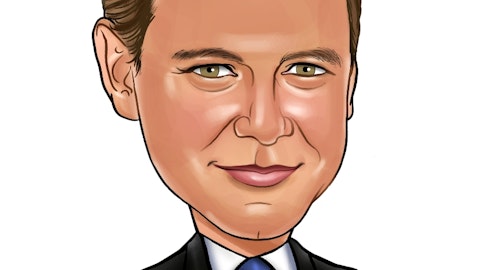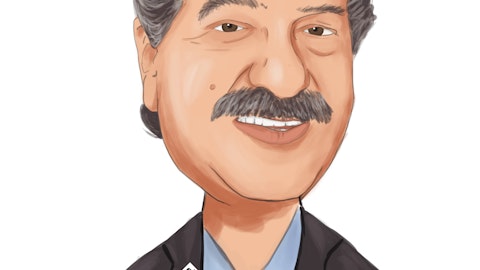Karen Zaderej: Well, as we’ve talked about before, we think the conversion process in trauma, well, it’s a very large market, it’s just hampered by the very nature of the fact that it’s an unscheduled procedure, and surgeons don’t take trauma call every day in a given month. And so we think that the trauma growth will continue to be paced through continued growth but having to reach those surgeons in a longer time frame with a greater number of adoption steps. In scheduled procedures, by the very nature of the fact that they’re scheduled, you can plan to be with the surgeon as they adopt a new technology, work with them in those cases and help change their practice patterns over a more discrete amount of time. So we think the adoption process and scheduled cases can be more rapid than what you see in trauma. So it’s a blend of those two that is what made up our overall guidance.
Mike Sarcone: Okay. Thanks, Karen. And maybe if I could just squeeze one last one in. Can you maybe just elaborate on how you’re thinking about seasonality and sales cadence through the year?
Karen Zaderej: Yeah. Great question. So as we’ve talked about in the past, trauma is — has a peak during the time periods where people are more active. And so as our business was originally trauma, you saw a cadence where first quarter to second quarter, there was a big jump up. Second quarter to third quarter, there was another jump up. And then it was basically flat to down in fourth quarter, and then sequentially, again, flat to down into the first quarter of the next year. Scheduled cases don’t follow that cadence. So you’re seeing some shifts in our cadence and seasonality, where scheduled cases will be driven, like most other elective scheduled procedures, they tend to be heavy towards the end of the year. A little slight nuance difference for breast reconstruction, where many women prefer not to have their breast reconstruction during that holiday period.
But in most scheduled elective procedures, you’ll see a push towards the end of the year and it will be a little bit lighter at the beginning of the year and then more of a steady slope through the — throughout the year. So again, we’re going to see some shifts over time in the cadence quarter-to-quarter as we balance between trauma and scheduled cases.
Mike Sarcone: Okay. Thanks, Karen.
Operator: Thank you. Next question today is coming from Mike Kratky from Leerink Partners. Your line is now live.
Mike Kratky: Hi, everyone. Thanks for taking our questions. Great to see the agency alignment on the Avance BLA. What’s the latest you’ve been hearing from KOLs and physicians on the extent to which having that ultimate BLA approval could really drive higher utilization? And what are the key factors that are driving that?
Karen Zaderej: We’re really excited about continuing to move forward and getting to the final stage of our submission on the BLA. It’s been a long process for us. So we had a very productive meeting with the FDA that we think laid out a clear path for us as we go forward. So yeah, we are turning our sights not just to the submission, but to our commercialization post-BLA. Look, from a surgeon standpoint, the surgeons really care more about the data, and that RECON publication, then they care about the regulatory classification of a particular product. But we do think, it will be helpful to continue to drive standardization, especially with middle adopters and accounts as, again, becoming a premium standard product that they use in their nerve protection algorithm.
We also think that having the BLA, and again, the data will be helpful as we continue to work with payers to make sure that Avance is listed as nonexperimental on their — on payers’ algorithms. So we think that it will continue to be helpful as we continue to grow. But the first step actually was actually getting this recent publication of the RECON data, which we’re wanting to make sure that surgeons see so they can make an informed choice in their clinical decision-making.
Mike Kratky: Got it. Yeah, that makes sense. And then maybe just one separate one. You saw a great growth in the scheduled procedures in 4Q. Would be curious if you could provide some additional color on which procedures within that category were driving some of that growth? And whether you’ve seen some of that momentum continue so far in early 2024?
Karen Zaderej: Well, all — I mentioned in the script, all of our application areas grew. So we were really pleased across all of the areas and with all of our products. So it wasn’t one hit, it’s really for us to continue to develop and grow out this market. And we’ve seen continued enthusiasm for that growth and expansion in — as we’ve entered here into Q1.
Mike Kratky: Understood. Thanks very much.
Operator: Thank you. Next question is coming from Caitlin Cronin from Canaccord Genuity. Your line is now live.
Caitlin Cronin: Hi, thanks for taking the questions and congrats on a great quarter.
Karen Zaderej: Thanks, Caitlin.
Caitlin Cronin: Yeah. Just to start with 2024 guidance, it seems to imply a deceleration year-over-year at the midpoint, even though it seems like scheduled procedure growth has seemed to tick up. Any kind of reason for that? And where do you think the mix between scheduled and emerging trauma could trend really over time?
Karen Zaderej: Well, again, I think we’re taking a measured approach. We looked at this not just on them, we had great momentum coming out of the year, but really looking at the total year to take a measured approach and think about our overall guidance. And so that was the thinking behind it. Again, so far, we’ve been pleased how we saw the beginning of the year, but we’re wanting not to get out over our skis on this.
Caitlin Cronin: Okay. Makes sense. And where did active accounts end for the year?




